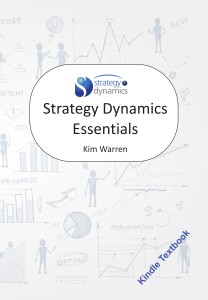Kim Warren on Strategy
Strategy insights and living business models
Strategy and sustainability
Had a couple of interesting contacts on this last week. Seems senior executives in general certainly ‘want to do what’s right’, but face two difficulties. First, it’s not as obvious as it seems to know what the right thing is to do [think of the debates about exploiting cheap labour vs. destitution and poverty]. Secondly, it’s hard for CEOs to make the business case for doing things that seem to be just costly. We can help on both issues.
First, my friend Tom Cummings at Executive Leadership Partnership has been doing some good events with top teams specifically on global warming. He and Drew Jones of the Sustainability Institute have taken groups through the C-roads simulator [previously ‘Pangaea’]- a decision-maker-oriented climate simulator to support climate policy design [it doesn’t need a super-computer, just a regular laptop!]. Also involved in this effort are Felicitas von Peter Director of the Forum for Active Philanthropy in Berlin and Dr. Robert W. Corell, IPCC scientist and Vice President for Programs at the Heinz Center.
Why take business teams through this? – because they, like most folk, lack an understanding of the basic but critical issues. For example, if we cut CO2 emissions, we might imagine that atmospheric CO2 levels would fall – they won’t. If your bath is about to overflow, turning the tap down [faucet for US friends] won’t stop it!. We may also think that if CO2 levels don’t rise, global warming will stop. It won’t – what’s already up there will keep trapping heat. The C-roads simulator connects these and other issues to the diverse implications for populations in different economic circumstances – developed and developing economies, and the poorest. More on related issues at the European Environment Agency, European Climate Foundation, and Tallberg Foundation. Only if management understands these and other mechanisms will they understand how their organizations’ activities are involved and see why and how to change things.
The thing that sets apart what Tom and his network are trying to do is its ultimately practical purpose – helping top teams work out what’s right to do and how to get it done fast, whilst at the same time supporting and even enhancing business performance. I have bumped into some disappointing initiatives in this area, e.g. arcane attempts to model the infinite complexity of everything, and ego-driven back-biting amongst fringe scientists and pressure groups. The danger of both is that they suck attention, effort and cash away from real efforts to fix the problems.
The second step Tom wants to pursue is helping top teams integrate sustainability considerations with organizational strategy. By coincidence, I also attended a reception with Forum for the Future, launching their report “Acting Now for a Positive 2018, preparing for radical change: the next decade of business and sustainability” [by all means download this, but please save paper and don’t print it!], authored by David Bent and others, and sponsored by CapGemini‘s head of corporate social responsibility, James Robey. Capgemini’s commitment to sustainability is admirable – according to their speaker, Christine Hodgson, they decided they just had to set some targets and get started, even if the targets weren’t perfect.
The challenge for both Tom at ELP and David at FftF is to help organizations embed sustainability into their strategy, and that requires embedding a rigorous analysis of how those organizations’ business systems integrate with the external factors of concern – scarce resources, CO2 emissions, waste, and social issues. This is exactly what strategy dynamics does, so I and my friend Suresh Mistry at Strategy Dynamics Solutions are working to help in these efforts.
Copyright © 2026 Kim Warren on Strategy. All rights reserved

